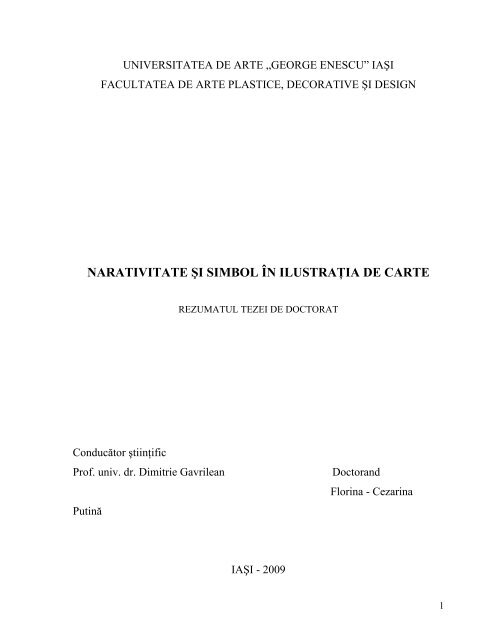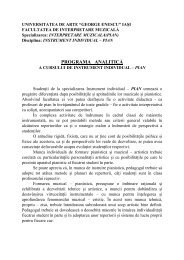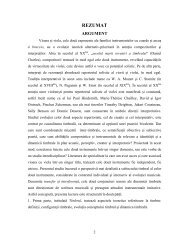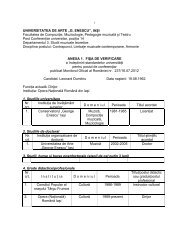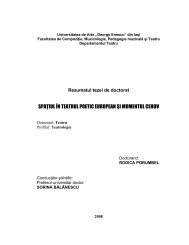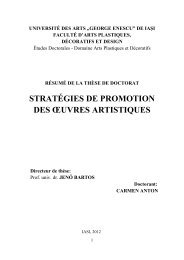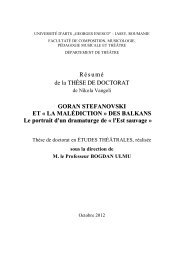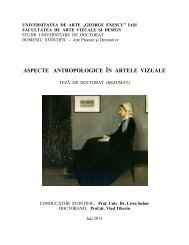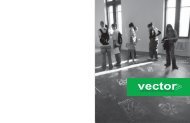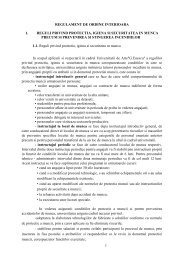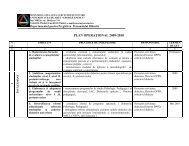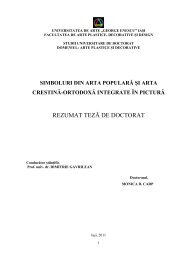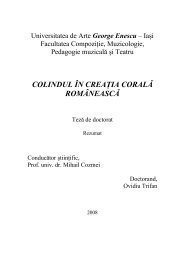Caloian Cezarina - Universitatea de Arte "George Enescu"
Caloian Cezarina - Universitatea de Arte "George Enescu"
Caloian Cezarina - Universitatea de Arte "George Enescu"
Create successful ePaper yourself
Turn your PDF publications into a flip-book with our unique Google optimized e-Paper software.
UNIVERSITATEA DE ARTE „GEORGE ENESCU” IAŞI<br />
FACULTATEA DE ARTE PLASTICE, DECORATIVE ŞI DESIGN<br />
NARATIVITATE ŞI SIMBOL ÎN ILUSTRAŢIA DE CARTE<br />
Conducător ştiinţific<br />
REZUMATUL TEZEI DE DOCTORAT<br />
Prof. univ. dr. Dimitrie Gavrilean Doctorand<br />
Putină<br />
IAŞI - 2009<br />
Florina - <strong>Cezarina</strong><br />
1
CONTENTS:<br />
SUMMARY.....................…………………………………………………………………..3<br />
CHAP. I. ILLUSTRATION, NARRATIVE AND SYMBOL...……………………….......7<br />
I.1. Book illustration, general presentation.…………………………………………….7<br />
I.2. Narativity and symbol – general consi<strong>de</strong>rations..……………………………….....10<br />
I.3. Image-text relations, semiotic perspective...……………………………………….13<br />
CHAP. II. HISTORY OF BOOK ILLUSTRATION.………………………..…………….17<br />
II.1. The illuminated manuscript from Antiquity to Middles Ages.……………………17<br />
II. 1. 1 Characteristics...…………………………………………………………...22<br />
II.2. Introduction of the printing press – essential moment in the evolution of the book<br />
and in spreading the culture.....................................................................................35<br />
II.2.1. Incunabula. The 15th century.....……………………………………………35<br />
II.2.2. The art of book <strong>de</strong>coration in the 16th – 17th centuries....……………….....40<br />
II.3. The book in the 18th century......…………………………………………………..45<br />
II.4. Book graphics in the 19th-21st centuries....…………………………………….....54<br />
II.5. Book graphics in Romania....………………………………………...……………92<br />
CHAP. III. GRAPHICS FOR CHILDREN’S BOOKS.…………………………………...105<br />
III.1. General consi<strong>de</strong>rations.………………………………………………………......105<br />
III.2. The stages of book illustration...…………………………………………………107<br />
III.3. The narrative illustration.....…………………………………………………..….109<br />
III.4. The visual perception of children..……………………………………………….111<br />
CAP. IV. CHARACTERISTICS OF BOOK ILLUSTRATION. ....……………………...116<br />
IV.1. Building the support surface.................……………………………………….....116<br />
IV.2. The significance of figuring......…………………………………………….…....124<br />
IV.2.1. The human image – typologies.……………………………………….....125<br />
IV.2.2. The humanized animals. The fantastic animals .………………………...126<br />
IV.3. Setting and clothing..........……………………………………………………….129<br />
2
IV.4. Characteristics..……………………………………………………………….….132<br />
IV.4.1. Dynamics and snap in illustration.....……………………………………....132<br />
IV.4.2. Simultaneous actions...……….…………………………………...……......134<br />
IV.4.3. The imaginary space..………………………………………………………137<br />
CAP. V. THE RELATION BETWEEN BOOK ILLUSTRATION AND THE EVOLUTION<br />
OF THE ARTISTIC TECHNIQUES....……………………………………………………139<br />
V.1. Writing types and supports......................………………………………………139<br />
V.2. Engraving.................…………………………………………………………....143<br />
V.2.1. The xylograph...………………………………………………………………145<br />
V.2.2. Engraving on metal ...........…………………………………...……………148<br />
V.2.3. The lithography anf the offset.…………………………………...…….......151<br />
V.3. Conventional and unconventional techniques..…………………..……………..154<br />
CAP. VI. PERSONAL CONTRIBUTIONS TO THE BOOK GRAPHICS...……………..160<br />
VI.1. Artistic activity......………………………………………………………………160<br />
VI.2. Personal illustrations..………………………………………………………...…163<br />
VI.2.1. The object-book............……………………………………………………166<br />
VI.4. List of works....……...…………………………………………………………..170<br />
CONCLUSIONS...…………………………………………………………………............174<br />
SELECTIVE BIBLIOGRAPHY....………………………………………………………...177<br />
SOURCE OF ILLUSTRATIONS.......……………………………………………………..182<br />
ANNEX I..………………………………………………………………………………….184<br />
ANNEX II..…………………………………………………………………………...…….203<br />
1. List of reproductions…………………………………………………………………...203<br />
2. List of illustrations..…………………………………………………………………...205<br />
ABSTRACT.……………………………………………………………………………….213<br />
3
KEY WORDS:<br />
Illustration, narration, symbol, graphics, narrative, engraving.<br />
NARRATIVITY AND SYMBOL IN BOOK ILLUSTRATION - SUMMARY<br />
SUMMARY<br />
Selection of a complex theme such as book illustration, approached from the<br />
perspective of the two image categories outlined following the transposition of a literary text in<br />
a visual plane, the narrative image and the symbolic one, is generated by my personal<br />
professional interests, as well as to the need of setting the benchmarks of book graphics<br />
<strong>de</strong>velopment from an historical and conceptual perspective and also from the constructive<br />
peculiarities. Relating to the two kinds of image arising following the <strong>de</strong>ep relationing between<br />
image and text and the poetical i<strong>de</strong>a translation in visual area, the researched an approached<br />
theme un<strong>de</strong>r the title “Narrativity and Symbol in Book Illustration”, aims at the theoretical and<br />
practical survey of the narrative image (it displays and narrates various events in a gradual<br />
succession along a series of illustrations) and the symbolic image (it uses signs and symbols in<br />
or<strong>de</strong>r to suggest an i<strong>de</strong>a or a mood or just to replace various happenings). In the domain of<br />
fine arts the book illustration has a clear position, representing an ever <strong>de</strong>veloping component<br />
that is important due to its artistic qualities – it expresses the most sensitive and profound<br />
i<strong>de</strong>as, <strong>de</strong>coding poetic universes through elements of plastic language – and also to the<br />
overwhelming share in <strong>de</strong>veloping the intellect, the sensitivity and the taste for beautiful of the<br />
child.<br />
Making a distinction in book graphics between illustrations for children and adults, the thesis<br />
consi<strong>de</strong>rs the evolution and changes created by a conceptual and technical perspective caused<br />
by the changes occurred in historical, social and cultural sphere.<br />
4
CHAP. I. ILLUSTRATION, NARRATIVE AND SYMBOL<br />
The thesis, “Narrativity and Symbol in Book Illustration”, structured in six sections<br />
completed with a bibliography and Annexes, proposes the observation of illustration evolution<br />
approached through the two concepts making an image that has to complete, <strong>de</strong>scribe and/or<br />
interpret a literary text: the narrative and the symbolic. In our survey we start from the i<strong>de</strong>a that<br />
the image can explain/express the i<strong>de</strong>as of a literary text appealing to the two concepts,<br />
explained in the first chapter, together with the relation types set between the two components<br />
of the illustrated book, the image and the text. In the first chapter of the research work we<br />
approach the features of book illustration from a general perspective showing the coordinates<br />
according to which we built the thesis. The narrative illustration, sequentially well structured,<br />
presents events and facts related by causal actions narrating in images. The image gains a<br />
symbolic value when assigned to it, hid<strong>de</strong>n, invisible significances and meanings but<br />
<strong>de</strong>tectable by means of the intelligible and the sensitivity. Consi<strong>de</strong>ring that the book illustration<br />
study requires an interdisciplinary research, we <strong>de</strong>dicated a subchapter to presenting the kinds<br />
of relations set between image and text from a semiotics perspective.<br />
CHAP. II. HISTORY OF BOOK ILLUSTRATION<br />
Approaching documentary materials (illustrated books, albums, articles and specialty<br />
studies in the field, as well as internet selected information) we suggest in chapter II an<br />
analysis of book illustration from an historical perspective, permanently enriched with the<br />
experience of some artists belonging to various epochs and art styles stressing their conceptual<br />
and technical personal contribution to book illustration <strong>de</strong>velopment.<br />
The concern in visually transposing of an i<strong>de</strong>a or a text dates back in ancient<br />
civilization times but we can talk about a peculiar interest on the subject matter in Middle Ages<br />
when the enlightened manuscript emerged. As our main concern is the literary text illustration,<br />
we notice a new turn the book illustration took beginning with the 15 th – 17 th centuries, when<br />
the special interest is focused on ornamentation and <strong>de</strong>coration quality by the contribution of<br />
printing press and Renaissance artists, new pathfin<strong>de</strong>rs regarding the illustrated book.<br />
remarking the novelties the 18 th century technically brought ( woodcut perpendicular carved<br />
5
to wood fiber and lithography), our research stresses the increased interest in children book<br />
illustration, as well as in the symbolic one shown during this century. The 19 th century brought<br />
important changes related to printing technology (by chromatography innovation), as well as<br />
from the perspective of the image <strong>de</strong>crypting a literary text, more varied as style and way of<br />
approaching, on the ground of a special attention shown to illustration that penetrated in<br />
pressing operations. Major changes took place at the conceptual level too: Grandville showed<br />
fabulous characters <strong>de</strong>lineating “Une autre mon<strong>de</strong>” in 1844, Walter Crane initiated the fully<br />
illustrated children book paying an increased attention to page surface arrangement, Aubrey<br />
Beardsley synthesized at the beginning of 20 th century The Art Nouveau style in illustrations<br />
carried out with minimal plastic means. The Russian illustrators transferred the tale characters<br />
in a traditional atmosphere with specific backgrounds and clothes and Beatrix Potter created<br />
the most humanized <strong>de</strong>licate characters. The 20 th century brought remarkable innovations in<br />
approaching book illustration and our research pointed out the variety of art styles, plastic<br />
visions and technical explorations.. Regarding the exploration simplifying and form<br />
metamorphosis, we mentioned the work of illustrators Iela Mari and Leo Lionni, innovators<br />
from the point of view of stylizing and economy of plastic expression means within the image<br />
for children, although all these had a maximum plasticity effect.<br />
Becoming aware of the close relations of illustration and graphical techniques, we<br />
un<strong>de</strong>rlined the technical innovations brought by artists along the centuries to the contemporary<br />
procedures facilitating the image and text transfer on paper sheets.<br />
CHAP. III. GRAPHICS FOR CHILDREN’S BOOKS<br />
The illustrated book is present in the life of all of us, starting with childhood (gaining a<br />
ludic value) due to its beauty, attractiveness, spectacular and easy un<strong>de</strong>rstanding.<br />
Becoming aware of the educational role of the illustration book <strong>de</strong>stined to the young ones by<br />
duplicating in images of the features for children literature in suggesting and creating positive<br />
mo<strong>de</strong>ls (always the heroes are given physical and spiritual qualities, being honest, brave, good,<br />
striving for justice, not breaking the ethical and moral norms) but also in transmitting<br />
information on environmental world, playing a role in <strong>de</strong>veloping child consciousness, we<br />
6
propose <strong>de</strong>ep survey of children book graphics in chapter III, stressing the narrative illustration<br />
features, the way it is perceived and built by the illustrator.<br />
Illustration aimed to children presents certain types of specificity, showed and analyzed<br />
in chapter III: the image is clear and expressive, the elements are rich in <strong>de</strong>tails and<br />
information, the characters and protagonistic elements of a scene are recogniscible,<br />
The frame the action is running in is legible and the character action <strong>de</strong>scription is carried out<br />
by gestures, mimicry and expressiveness. The story advances from one image to another in<br />
their successive or<strong>de</strong>r and is irreversible, and there is an inevitable logic of visual discourse.<br />
The working out of an illustration, coming out of a cooperation between two different<br />
fields – literature and fine arts – that convey the message by their own means – the word and<br />
the image - requires from the illustrator a creative thinking and the gift to handle the artistic<br />
techniques. Besi<strong>de</strong> the illustrator’s ability it is also necessary an active involvement of the<br />
receiver for the message un<strong>de</strong>rstanding, the illustration playing the role of enriching the text<br />
with visual meanings. We also <strong>de</strong>limited and explained the steps the illustrator passed through,<br />
steps necessary for an efficient and expressive elaboration of the illustrations: the setting of<br />
the public the book is addressed to, of <strong>de</strong>tails related to technical conditions (black/white or<br />
colour, size, page arrangement, etc.) full un<strong>de</strong>rstanding of the text to be <strong>de</strong>crypted, the<br />
documentation and research stage (essential because the illustrator must follow the historical<br />
coordinates the action is taking place, paying attention to socio-cultural references, to custom<br />
and clothing <strong>de</strong>tails), documentation on previous works illustrating the same text, finding out<br />
the key elements of the text offering <strong>de</strong>ep meanings, the setting and tracing the composing<br />
structure and the proper image realization.<br />
A main concern of our research is to establish the narrative illustration features used<br />
prepon<strong>de</strong>rantly in the book aimed at the little ones and also setting the elements related to the<br />
visual perception and i<strong>de</strong>ntification of children. We also stressed the educative role of<br />
illustration (it enriches the knowledge and the vocabulary of the little receiver, <strong>de</strong>veloping his<br />
visual thinking, as well as his memory), it re-asserts the importance of the image in children<br />
book.<br />
7
CAP. IV. CHARACTERISTICS OF BOOK ILLUSTRATION<br />
In chapter IV, the illustrated book is analyzed as a whole starting from the support<br />
structure, the particular features of the cover, illustration and text, the latter gaining in certain<br />
circumstances a graphical role. The character, leading actor in illustration is studied from its<br />
complexity perspective of ren<strong>de</strong>red typologies, but mainly viewed from a miraculous and<br />
imaginary perspective, basic aspects in the children’s book. The humanized character, of<br />
animal or vegetal origin, lives together with the fantastic character in a world that associates<br />
the real with the unreal, the infinitesimal with the gigantesque, resulting unusual but coherent<br />
images. The truthfulness of these characters and situations is supported by clothing and<br />
scenery, these elements having the capacity of introducing the action and implicitly the<br />
receiver (onlooker/rea<strong>de</strong>r) into the atmosphere of a certain époque, offering, at the same time,<br />
documented information. Our research i<strong>de</strong>ntifies also the issues related to ren<strong>de</strong>r the dynamics<br />
and the event succession, of simultaneous actions and imaginary space, aspects present in book<br />
illustration.<br />
CAP. V. THE RELATION BETWEEN BOOK ILLUSTRATION AND THE<br />
EVOLUTION OF THE ARTISTIC TECHNIQUES<br />
The illustration benefits of the unlimited achieving possibilities, appealing to drawing<br />
that is <strong>de</strong>fining for all sorts of graphics, consisting of using all the elements of plastic language<br />
and ren<strong>de</strong>ring some real and unreal images, but also engraving techniques which evolution it is<br />
closely related. Hand drawing, with special tracing tools of the line and using materials specific<br />
for conventional and unconventional techniques, or, more recently, with the help of computer<br />
image processing programs, the book illustration is presented in a variety of forms. In spite of<br />
the fact that at beginning it was carried out by hand painting of the parchment or paper page,<br />
the illustration is closely related with engraving techniques, subject largely <strong>de</strong>bated in section<br />
V. These facts imply the transposition of the drawing, previously ma<strong>de</strong> on a support plate,<br />
<strong>de</strong>pending on the techniques (wood, linoleum, metal, aluminum etc), the use of some specific<br />
tools (engraving needle, burnisher, balancer, crayon, lithographic chalk and ink) and printing<br />
on paper of the engraved images with the help of a press and special typographic inks.<br />
8
The survey is aimed also to the conventional artistic techniques used along the time in<br />
book graphics (ink drawing with nib, aquatint, water colors, tempera, gouache etc) of mixed<br />
techniques but also of the unconventional ones (monotype, collage), observing the multitu<strong>de</strong><br />
and the variety of plastic expression means. In the contemporary époque, the technical<br />
innovations are doubled in illustration in new concept trends and experimental approaches able<br />
of discerning and expressing the meaning of the poetic universes.<br />
CAP. VI. PERSONAL CONTRIBUTIONS TO THE BOOK GRAPHICS<br />
In chapter VI we propose <strong>de</strong>bating on approach subject and its particularities, putting in<br />
discussion certain aspects of personal creation, related to transposition in visual sphere of<br />
specific elements of the poetic universes interpreted through the filter specific to the own<br />
sensitivity exemplified by images belonging to published illustrated books or object books. By<br />
the works presented in chapter VI and Appendix I, we would like to illustrate some ways of<br />
approaching book illustrations, both narrative and symbolical, ascertaining the personal<br />
concern for symbolic image.<br />
CONCLUSIONS<br />
Concluding, we reassert the fact that the book illustration is still a field of maximum<br />
interest in continuous change, a sort of cultural mirror of the society, a complex form of interhuman<br />
knowledge and communication, both from the perspective of creative activity of the<br />
illustrator and from the perspective of the receiving public.<br />
SELECTIVE BIBLIOGRAPHY<br />
Al<strong>de</strong>rsen, Brian, A view from the island. European Picture Books 1967-1976, în Illustrators<br />
of children’s books 1967-1976, compilaţie <strong>de</strong> Lee Kingman, Grace Allen Hogarth şi<br />
Harriet Quimby, The Horn Book, INC Boston, 1978<br />
Andreeascu, Ana, Arta cărţii. Cartea românească în secolele XVI-XVII, Editura Integral,<br />
Bucureşti, 1997<br />
- Arta cărţii: cartea românească veche, Editura Capitel, Bucureşti, 2006.<br />
9
- Cartea românească în veacul al XVIII-lea, Editura Vremea XXI, Bucureşti, 2004<br />
Arnheim, Rudolf, Arta şi percepţia vizuală, Editura Meridiane, Bucureşti, 1979<br />
Averill, Esther, Avant-gar<strong>de</strong>s and tradition in France, în Contemporary Ilustrators of<br />
Children’s Books, compilaţie <strong>de</strong> Bertha E. Mahony şi Elinor Whitney, republicată <strong>de</strong><br />
Gale Research Company, Book Tower, Ditroit, 1987<br />
Barbu, Violeta, Miniatura brâncovenească. Manuscrise miniate şi ornamentate, Editura<br />
Meridiane, Bucureşti, 2000<br />
Bachelard, Gaston, Poetica spaţiului, Editura Paralela 45, Piteşti, 2003<br />
- Poetica reveriei, Editura Paralela 45, Piteşti, 2005<br />
Bassoli, Milena, Un'avventura e un'arte. Viaggio nella storia <strong>de</strong>l libro attraverso le collezioni<br />
<strong>de</strong>lla Biblioteca comunale, Trento, Comune di Trento, 2000<br />
Barbier, Fe<strong>de</strong>ric, Histoire du livre, Edition Armand Colin, Paris, 2000<br />
Bie<strong>de</strong>rmann, Hans, Dicţionar <strong>de</strong> simboluri, 2 vol., Editura Saeculum, Bucureşti, 2002<br />
Bland, David, A History of Book Illustration: The Illuminated Manuscris and the Printed<br />
Book, Cleveland: World Publishing Company, 1985.<br />
Blasselle, Bruno, Histoire du livre, Gallimard, Paris, 2000<br />
Brown, Marcia, Distinction in Picture Book, în Illustrators of children’s books 1946-1956 ,<br />
compilaţie <strong>de</strong> Marcia Dalphin, Ruth Hill Vigures şi Bertha Mahony Miller, The<br />
Horn Book INC, Boston, 1958<br />
Cârneci, Magda, Ilustraţia <strong>de</strong> carte, în revista Arta, nr 9, 1981<br />
Cernăuţi – Goro<strong>de</strong>ţchi, Mihaela, Poetica basmului mo<strong>de</strong>rn, Ediţia a II-a revizuită, prefaţă <strong>de</strong><br />
Dumitru Irimia, Editura Universitas, Iaşi, 2002<br />
Cheşuţ, Cristian, Lu<strong>de</strong>o, ergo sum. Păpuşi, mingi, teorii, Editura Limes, Cluj-Napoca, 2005<br />
- Designul grafic şi literatura pentru copii, Editura Limes, Cluj-Napoca, 2008<br />
Cianciolo, Patricia, Illustrators in children’s books, WM.C. Brown Company Publishers, a<br />
treia ediţie, 1972<br />
Clebert, Jean-Paul, Bestiar fabulos: dicţionar <strong>de</strong> simboluri animaliere, Editura <strong>Arte</strong>mis<br />
Cavallioti, Bucureşti, 1995<br />
Demetrescu Roxana, Aubrey Vincent Beardsley, Colecţia Cabinetul <strong>de</strong> Stampe, Editura<br />
Meridiane, Bucureşti, 1986.<br />
Dittman, Lorenz, Stil· Simbol· Structură, Editura Meridiane, Bucureşti, 1988<br />
10
Durand, Marion, Bertrand Gérard, L’Image dans le livre pour les enfants, L’École <strong>de</strong>s<br />
Loisirs, Paris, 1975<br />
Dan, Călin, Misterele cărţii, în revista Arta, nr 4/1989<br />
- Silviu Băiaş – Portret, în revista Arta, nr 4/1989<br />
Eco, Umberto, O teorie a semioticii, Meridiane, Bucureşti, 2002<br />
Eichenberg, Fritz, The Picture Book, în Illustrators of children’s books 1946-1956 ,<br />
compilaţie <strong>de</strong> Marcia Dalphin, Ruth Hill Vigures şi Bertha Mahony Miller, The Horn<br />
Book INC, Boston, 1958<br />
Enache, Mariana, Ilustraţii şi povestiri, în revista Arta, nr 12, 1989, pag.12<br />
Feaver, William, Les images <strong>de</strong> notre enfance. Deux siècles d’illustration <strong>de</strong> livres d’enfants,<br />
Edition Chêne, Paris, 1976<br />
Fouché, Pascal, Dictionnaire encyclopédique du livre,vol. I, II, Édition du Cercle <strong>de</strong> la<br />
Librairie, Paris, 2002<br />
Golznetc, Sergei, Ivan Bilibin, Aurora Art Publishers, Leningrad, 1981<br />
Geck, Elisabeth, Gutenberg şi arta tiparului, Editura Meridiane, Bucureşti, 1973.<br />
Grigorescu, Dan, Ilustraţii şi ilustratori ai operi lui Ion Creangă, în Tribuna României, nr.<br />
342, 15 iunie 1987<br />
- Vasile Kazar, Editura Meridiane, Bucureşti, 1988<br />
Hofer, Philip, Ilustrators of Children’s Clasics – în Illustrators of children’s books 1967-<br />
1976, compilaţie <strong>de</strong> Lee Kingman, Grace Allen Hogarth şi Harriet Quimby, The Horn<br />
Book, INC Boston, 1978<br />
Katz, Bill (editor), A history of book illustration. 29 points of view, The Scarecrow Press,<br />
Inc. Metuchen, N.J.&London, 1994<br />
Krejča, Aleš, Las técnicas <strong>de</strong>l grabado. Guía <strong>de</strong> la técnicas y <strong>de</strong> la istoria <strong>de</strong>l grabado <strong>de</strong><br />
arte original, Collection „Técnicas <strong>de</strong>l <strong>Arte</strong>”, Editorial Libsa, Madrid, 1990.<br />
Labarre, Albert, Istoria Cărţii, Institutul European, Iaşi, 2001<br />
Lapşina, Natalia, Mir Iskusstva, Editura Meridiane, Bucureşti, 1980<br />
Laven<strong>de</strong>r Nicholas, Judy, Educational Impact of Picture Book Illustration, VDM Verlang Dr.<br />
Muller, 2008.<br />
Lebmann-Haupt, Hellmuth, Animated drawing, în Book Illustration. The State of Art, în<br />
Illustrators of children’s books 1967-1976, compilaţie <strong>de</strong> Lee Kingman, Grace<br />
11
Allen Hogarth şi Harriet Quimby, The Horn Book, INC Boston, 1978<br />
Lorraine, Walter, Book Illustration. The State of Art, în în Illustrators of children’s books<br />
1967-1976, compilaţie <strong>de</strong> Lee Kingman, Grace Allen Hogarth şi Harriet Quimby,<br />
The Horn Book, INC Boston, 1978<br />
MacIntosh Schwandt, Frances, The German Group, în Contemporary Ilustrators of<br />
Children’s Books, compilaţie <strong>de</strong> Bertha E. Mahony şi Elinor Whitney, republicată<br />
<strong>de</strong> Gale Research Company, Book Tower, Detroit, 1987<br />
Marcey Stone, Wilbur, The Bewicks: Thomas and John, în Contemporary Ilustrators of<br />
Children’s Books, compilaţie <strong>de</strong> Bertha E. Mahony şi Elinor Whitney, republicată <strong>de</strong><br />
Gale Research Company, Book Tower, Detroit, 1987<br />
Mănescu, Mihai, Tehnici <strong>de</strong> figurare în gravură, Editura Tehnică, Bucureşti, 2005<br />
Olteanu, Virgil, Ilustratori români. Repere bibliofile, Editura Retromond, Bucureşti, 2001<br />
Overton, Jacqueline, Ilustrators of the Nineteenth Century in England, în Illustrators of<br />
children’s books 1967-1976, compilaţie <strong>de</strong> Lee Kingman, Grace Allen Hogarth şi<br />
Harriet Quimby, The Horn Book, INC Boston, 1978<br />
- The Fairies come into their own. <strong>George</strong> Cruickshank, Richard Doyle, John Tenniel<br />
and Arthur Hughes, în Contemporary Ilustrators of Children’s Books, compilaţie <strong>de</strong><br />
Bertha E. Mahony şi ElinorWhitney, republicată <strong>de</strong> Gale Research Company, Book<br />
Tower, Detroit, 1987<br />
Popecu Vîlcea, Gheorghe, Miniaturi româneşti. Miniatura şi ornamentul manuscriselor<br />
Româneşti, Editura Meridiane, Bucureşti, 1998<br />
Redlow, Theodor, Silviu Băiaş, în revista Arta, nr 9, 1984<br />
Sebeok, Thomas, Semnele: o introducere în semiotică, Editura Humanitas, Bucureşti, 2002<br />
Simionescu, Dan, Buluţă, Gheorghe, Pagini din istoria cărţii româneşti, Editura Ion Creangă,<br />
Bucureşti, 1981<br />
Slessor, Catherine, The Art of Aubrey Beardsley, Silverdale Books, 2004<br />
Spielman, M.H., History of Punch, în Contemporary Ilustrators of Children’s Books,<br />
compilaţie <strong>de</strong> Bertha E. Mahony şi Elinor Whitney, republicată <strong>de</strong> Gale Research<br />
Company, Book Tower, Detroit, 1987<br />
Steinberg, S.H., Five hundred years of printing, a treia ediţie, Penguin Books, 1974<br />
Tîrnăuceanu, Mariana, Lumea cărţii ilustrate ilustrate. O perspectivă semiotică, Editura Pim,<br />
12
Iaşi, 2008<br />
Thaxter Eaton, Anne, Illustrators Books for Children Before 1800, în Illustrators of<br />
children’s books 1967-1976, compilaţie <strong>de</strong> Lee Kingman, Grace Allen Hogarth şi<br />
Harriet Quimby, The Horn Book, INC Boston, 1978<br />
Vida, Gheorghe, Alfabetul lui Silviu Băiaş – un „theatrum mundi” pentru copii, în revista<br />
Arta, nr 4/1989<br />
Walter, Ingo F., Wolf, Norbert, Masterpieces of Illumination. The world’s most beautifull<br />
illuminated manuscripts from 400 to 1600, Taschen, Köln, 2005<br />
Ward, Lynd, The Book Artist: I<strong>de</strong>as and techniques, în Illustrators of children’s books 1946-<br />
1956, compilaţie <strong>de</strong> Marcia Dalphin, Ruth Hill Vigures şi Bertha Mahony Miller, The<br />
Horn Book INC, Boston, 1958<br />
Zeegan, Lawrence, The Fundamentals of Illustration, AVA Publishing SA, Lausanne, 2005.<br />
*** Contemporary Ilustrators of Children’s Books, compilaţie <strong>de</strong> Bertha E. Mahony şi<br />
Elinor Whitney, republicată <strong>de</strong> Gale Research Company, Book Tower, Detroit, 1987<br />
*** Guya Completa <strong>de</strong> illustration y <strong>de</strong>seno. Tecnicas y materias. Coordonado por Terence<br />
Dally. Tucen Hermann Blume Editiones, 1992<br />
*** Ilustrators of Children’s Books 1744 - 1945, compilaţie <strong>de</strong> Bertha E. Mahony, Beulah<br />
Folmsbee şi Loiuse Payson Latimer, The Horn Book, INC Boston, 1962<br />
*** Illustrators of children’s books 1946-1956 , compilaţie <strong>de</strong> Marcia Dalphin, Ruth Hill<br />
Vigures şi Bertha Mahony Miller, The Horn Book INC, Boston, 1958<br />
*** Illustration Now!, Tachen, Berlin, 2005<br />
*** Illustrators - Sourcebook. 1850 – to Present Day, foreword by Paul Hogarth, Nick &<br />
Tessa Souter, London, 1990<br />
*** Illusive: Contemporary Illustration and Its context, editori Robert Klaten si Hendrik<br />
Hellige, 2005<br />
*** L’enfant, l’image et le récit, Monton Editeur Paris/ La Haye New York, coordonator<br />
Denise Escarpit<br />
*** The Complete – Illustrated Lewis Carrol, with an introduction by Alexan<strong>de</strong>r Wollcott,<br />
Wordsworth Edition, a III-a publicare, 1998<br />
*** The Dictionary of Art, 40 volume, editor Jane Turner, Grove’s Dictionary Inc., New<br />
York, 1996.<br />
13
ANNEX II: Personal graphic works realized between 2004-2009<br />
ANNEX II: List of reproductions<br />
List of illustrations<br />
14


